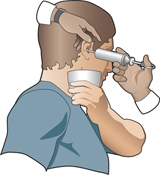Module 1
1. Module 1
1.35. Page 2
Module 1—The Nervous System
 Explore
Explore
Outer Ear
outer ear: one of the three main regions of the ear, which consists of the pinna and the auditory canal and ends at the tympanum or eardrum
middle ear: one of the three main regions of the ear, which begins just past the tympanum and consists of a chamber containing three tiny bones (ossicles) called the malleus (hammer), the incus (anvil), and the stapes (stirrup); leads into a minute opening called the Eustachian tube
inner ear: one of the three regions of the ear that is located deepest in the head and consists of a fluid-filled chamber containing the semicircular canals, the utricle, the saccule, and the cochlea
pinna: the outer flap of the ear that is composed of skin and cartilage and shaped so that it enhances sound vibrations and funnels them into the auditory canal
sound wave: a series of compressions and rarefactions resulting in an S-shaped curve or sine wave
vestigial: small or imperfectly developed; often referring to a part or organ that was once more fully developed in an earlier evolutionary stage, but is now non-functional
There are three major regions in the ear: the outer ear, the middle ear, and the inner ear. You will explore all three regions in this lesson.
The most obvious structure of the outer ear is the pinna. Some animals can move their pinnae to maximize their ability to trap sound waves. By moving its pinnae, the fennel fox, shown below, can pinpoint with great accuracy the direction from which a sound originates. For many animals, survival is dependent on early detection of sound. In humans, the muscles of the pinna are vestigial, or nonfunctional, and the pinnae can’t be moved. However, people sometimes cup an ear with a hand to simulate an enlarged pinna in order to help them hear well. Do you know anyone who can actually move his or her pinnae?

© Khirman Vladimir/shutterstock

© Inger Anne Hulbækdal/shutterstock
 Read
Read
Read from page 419 to the heading “Frequencies of Sound” on page 421 in your textbook, and note “Figure 12.20.” You will find that including a labelled diagram in your notes is a useful study tool.
 Self-Check
Self-Check
auditory canal: a short channel that conducts sound waves from outside the ear to the tympanum; amplifies or makes sounds louder
tympanum: a round elastic structure located in the middle ear that vibrates in response to sound waves; also called the eardrum or tympanic membrane
SC 1. Locate the pinna and the auditory canal. What is the function of these structures?
SC 2. What does cupping the ear accomplish?
SC 3. The auditory canal produces ear wax. What is the purpose of this wax?
SC 4. What else does the auditory canal do?
SC 5. Wax buildup can be a cause of conductive deafness. Look at the image below. What is the syringe used for?

SC 6. The auditory canal ends at the tympanum. Can you hypothesize what the function of the tympanic membrane might be?
 Self-Check Answers
Self-Check Answers
SC 1. The pinna and auditory canal collect and direct sound waves.
SC 2. Cupping the ear helps to collect and direct more sound waves.
SC 3. The wax moistens the passage and eardrum for flexibility and collects debris.
SC 4. The auditory canal also channels out debris and directs sound to the tympanic membrane.
SC 5. The syringe is used to fill the auditory canal with warm water to float out pieces of wax and remove wax buildup.
SC 6. Sound waves cause the tympanum to vibrate, converting sound energy to mechanical energy.
To review the structures found in the outer ear and their functions, summarize your understanding by creating a table similar to the one below. Save the table in your course folder for later access.
THE STRUCTURES AND FUNCTIONS OF THE OUTER EAR
Structure |
Function(s) |
|
|
|
|
|
|